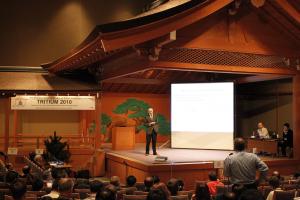The Fellowship of Tritium
10 Nov 2010
-
Robert Arnoux
Due to the historical significance of the conference venue, Manfred Glugla, like all participants, had to leave his shoes at the door. And present ITER's deuterium-tritium fuel cycle process system wearing slippers ...
They come from every walk of science and technology. Some of them design large plants while others manufacture small equipment, work in defence labs, astrophysics research centres, health or environmental agencies ...
Whatever the nature of their work, they share a common interest in a light and elusive element: tritium. They are the members of the "worldwide tritium community," eager to learn, confront their experience and address the various challenges they are faced with.
The tritium community gathers every three years for a three-day conference, usually "close to where the action is," like they did in Rochester, N.Y. (US) in 2007, or in Baden-Baden, near Karlsruhe, Germany, in 2004.
From 24 to 29 October this year, the community met in Nara, Japan. No tritium lab or CANDU plant nearby, but, for a change, one of the largest concentration of World Heritage Sites and National Treasures—the city was the imperial capital of Japan in the 8th century and has retained the best part of its architectural wonders.
"You learn a lot during these gatherings," says Manfred Glugla, ITER Fuel Cycle Engineering Division Head, who was part of the nine-member-strong ITER delegation to the conference. "You get opportunities to talk to people who look at problems from a different perspective, and you come back with new criteria, a new way of looking at this detail in this component ..."
At Nara, ITER was placed centre stage. Presentations on the deuterium-tritium fuel cycle process system by Manfred Glugla; on the safety approach on tritium-related issues, also by Glugla on behalf of Deputy Director-General Carlos Alejaldre who couldn't make the trip; on hot cell cleaning and decontamination methods by Section Leader Magali Benchikhoune, opened the five-day conference.
"The talks were well received and the participants were very keen to learn about our project," reflects Glugla. "In discussions, a very interesting issue was brought up. How will we make sure that we preserve and continue to develop the knowledge we accumulated in the R&D period through the present design and construction phases all the way to the system testing and tritium commissioning of ITER, all of which will take place several years from now? How do we bridge this gap?"
The issue is a crucial one and Manfred Glugla and his ITER colleagues are convinced that the answer lies in pursuing high-level university research, training a new generation of "knowledgeable people" and attracting them to projects that involve tritium handling—and particularly to ITER.
This is something the tritium community could discuss at greater length at the next conference in 2013, which could be held "somewhere in southern France"—maybe in Nice, or, even better, in Aix which combines proximity "to the action" and significant historical heritage.


